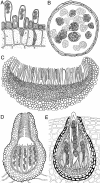Body plan evolution of ascomycetes, as inferred from an RNA polymerase II phylogeny
- PMID: 15070748
- PMCID: PMC384777
- DOI: 10.1073/pnas.0400938101
Body plan evolution of ascomycetes, as inferred from an RNA polymerase II phylogeny
Abstract
The mode of evolution of the biologically diverse forms of ascomycetes is not well understood, largely because the descent relationships remain unresolved. By using sequences of the nuclear gene RPB2, we have inferred with considerable resolution the phylogenetic relationships between major groups within the phylum Ascomycota. These relationships allow us to deduce a historical pattern of body plan evolution. Within Taphrinomycotina, the most basal group, two simple body plans exist: uncovered asci with unicellular growth, or rudimentary ascoma with hyphal growth. Ancestral ascomycetes were filamentous; hyphal growth was lost independently in the yeast forms of Taphrinomycotina and Saccharomycotina. Pezizomycotina, the sister group to Saccharomycotina, retained mycelial growth while elaborating two basic ontogenetic pathways for ascoma formation and centrum development. The RPB2 phylogeny shows with significant statistical support that taxa in Pezizomycotina with ascohymenial ontogeny (ascoma generally forms after nuclear pairing) are ancestral and paraphyletic, whereas ascolocular fungi with fissitunicate asci are a clade derived from them. Ascolocular lichens are polyphyletic, whereas ascohymenial lichens comprise a monophyletic group that includes the Lecanorales. Our data are not consistent with a derived origin of Eurotiomycetes including Aspergillus and Trichophyton from within a lichen-forming ancestral group. For these reasons, the results of this study are considerably at variance with the conclusion that major fungal lineages are derived from lichensymbiotic ancestors. Interpretation of our results in the context of early work suggests that ascoma ontogeny and centrum characters are not in conflict with the molecular data.
Figures



References
-
- Hawksworth, W. L., Kirk, P. M., Sutton, B. C. & Pegler, D. N. (1995) Ainsworth & Bisby's Dictionary of the Fungi (CAB International, Wallingford, Oxon, U.K.).
-
- Eriksson, O. (1981) Opera Botanica 60, 1–220.
-
- Luttrell, E. S. (1951) Univ. Mo. Stud. 3, 1–120.
-
- Luttrell, E. S. (1955) Mycologia 47, 511–532.
-
- Nannfeldt, J. A. (1932) Nova Acta Regiae Soc. Sci. Ups. 8, 1–368.
MeSH terms
Substances
Associated data
- Actions
- Actions
- Actions
- Actions
- Actions
- Actions
- Actions
- Actions
- Actions
- Actions
- Actions
- Actions
- Actions
- Actions
- Actions
- Actions
- Actions
- Actions
- Actions
- Actions
- Actions
- Actions
- Actions
- Actions
- Actions
- Actions
- Actions
- Actions
- Actions
- Actions
- Actions
- Actions
- Actions
- Actions
- Actions
- Actions
- Actions
- Actions
- Actions
- Actions
- Actions
- Actions
- Actions
- Actions
- Actions
- Actions
- Actions
- Actions
- Actions
- Actions
- Actions
- Actions
- Actions
- Actions
- Actions
- Actions
- Actions
- Actions
- Actions
- Actions
- Actions
- Actions
- Actions
- Actions
- Actions
- Actions
- Actions
- Actions
- Actions
- Actions
- Actions
- Actions
- Actions
- Actions
- Actions
- Actions
- Actions
- Actions
- Actions
- Actions
- Actions
- Actions
- Actions
- Actions
- Actions
- Actions
- Actions
- Actions
- Actions
- Actions
- Actions
- Actions
- Actions
- Actions
- Actions
- Actions
- Actions
- Actions
- Actions
- Actions
- Actions
- Actions
- Actions
- Actions
- Actions
- Actions
- Actions
- Actions
- Actions
- Actions
- Actions
- Actions
- Actions
- Actions
- Actions
- Actions
- Actions
- Actions
- Actions
- Actions
- Actions
- Actions
- Actions
LinkOut - more resources
Full Text Sources
Molecular Biology Databases

